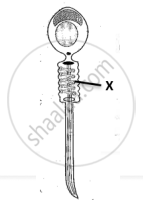Advertisements
Advertisements
Question
Describe the components of an ecosystem.
Solution
The region of the lithosphere, hydrosphere and atmosphere in which living beings live is called the biosphere. The study of the mutual relationships of biotic and abiotic components found in the biosphere is called an ecosystem. The word ecosystem was first used by Tansley (1935). If biotic, abiotic parts and geological, chemical and physical characteristics are included in the biosphere, it becomes an ecosystem.
An ecosystem is a natural system with a limited and definite physical environment in which the mutual economic relationship between the structure and functions of biotic and abiotic parts remains in balance. In this system, the flow of matter and energy takes place through well-planned routes.
Components of the ecosystem
There are mainly two components of the ecosystem - biotic and abiotic components.
- Biotic components – There are three types of biotic components in an ecosystem – autotrophic, heterotrophic and decomposers.
- Autotrophic component – Green plants are the autotrophic components of the ecosystem. They synthesize organic food materials through photosynthesis from CO2 and water in the presence of solar energy and chlorophyll. Green plants are also called producers. The food material stored in green plants is food for other organisms.

- Heterotrophic components – These cannot make their food; they depend directly or indirectly on plants for food. These are called consumers. There are three types of consumers –
- Primary-level consumers or Herbivores – These consumers get their food directly from the producers (green plants). They are called herbivores. Examples include cow, goat, buffalo, rat, deer, and rabbit.
- Secondary-level consumers or Carnivores – Secondary-level consumers eat herbivores animals for food, called carnivores like- frogs, snakes, etc.
- Tertiary-level consumers – Tertiary level consumers get food from secondary level consumers like- lion, cheetah, eagle etc. Some animals are omnivores, they can get food from plants or animals like- dog, cat, human being etc.
- Decomposers – These organisms break down organic substances into their components. They mainly decompose the dead bodies of producers and consumers. They are also called saprophytes. Generally, these are bacteria and fungi. As a result, the cycling of minerals continues in nature. Producers, consumers and decomposers together form biomass.
- Abiotic components – The abiotic components of any ecosystem can be divided into three parts –
- Climatic factors – water, heat, light, etc.
- Inorganic substances – C, O, N, CO2 etc. These enter the biological world through various cycles.
- Organic substances – proteins, carbohydrates, fats etc. These decompose and turn into simpler components again.
From a functional point of view, inorganic components are divided into two parts -
- Materials – Soil, atmospheric substances such as air, gas, water, CO2, O2, N2, salts such as Ca, S, P, organic acids etc.
- Energy – Various types of energy, such as solar energy, thermal energy, kinetic energy, chemical energy, etc.
APPEARS IN
RELATED QUESTIONS
Name the type of food chain that exists in a pond.
Answer the following question.
Mention four significant services that a healthy forest ecosystem provide.
Which of the following is/are not a natural ecosystem?
Pond ecosystem is
Solar energy used by green plants for photosynthesis is only
Which of the following is/are not the mechanism of decomposition
Name of the food chain which is generally present in all types of ecosystem. Explain and write their significance.
The shape of pyramid in a particular ecosystem is always different in shape. Explain with example.
Generally, human activities are against the ecosystem, whereas you a student how will you help to protect the ecosystem?
Denitrification is carried out by:
Photosynthesis is a/an:
Which of the following is the most stable ecosystem?
Which one of the following in not a functional of in ecosystem?
Decomposers like fungi and bacteria are ______.
The amount of nutrients, such as carbon, nitrogen, phosphorus, and calcium present in the soil at any given time, is referred to as ______
Among the following bio-geo-chemical cycles which one does not have losses due to respiration?
In the given figure of mammalian spermatozoon, “X” is an organelle. Identify the organelle.

A farmer has two fields in which he wants to grow a cereal crop and a legume. He cannot afford to spend a lot of money on chemical fertilisers to increase the fertility of the soil.
Suggest a way to help him resolve the issue.
